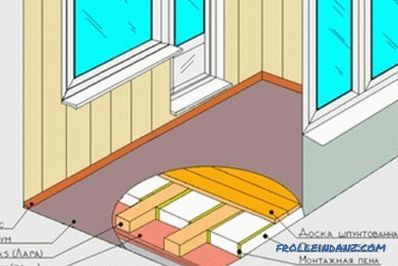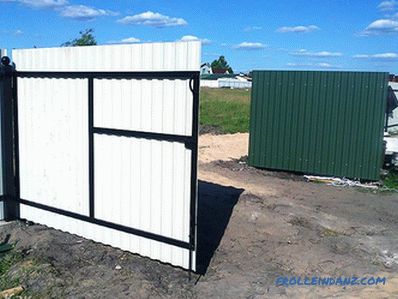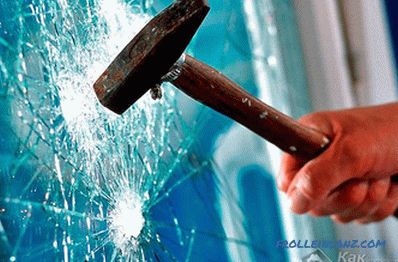Despite the fact that advanced technologies for space heating are now common, the heating system with natural circulation is in great demand. This is primarily due to the fact that it is easy to install, and if you also take into account the instability of providing the private sector with electricity, then the popularity of such an autonomous heating system becomes clear.
How it works
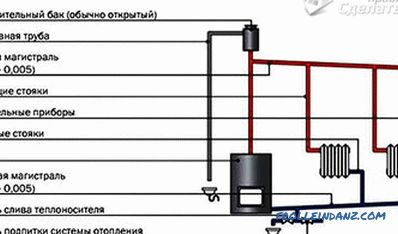 Scheme of the gravitational heating system
Scheme of the gravitational heating system
Immediately it should be said thanks to a special device, the system works without forced circulation of the coolant. The movement of water in the pipes occurs due to the fact that when cooled, the density of water increases, and it flows down to the boiler through pipes installed on an incline, pushing out heated water from it.
Although a natural circulation heating system can work without a pump, it is still better to install it. When the pump is turned on, the coolant flows faster through the pipes, therefore, the room warms up faster.
When leaving the boiler, the water enters the accelerating collector, reaches the top point through it, and through pipes installed at an incline from the boiler, while cooling, continues its way around.
Disadvantages and advantages
 We have to wait a long time
We have to wait a long time
First, let's talk about the disadvantages. Such an approach will help determine whether such a heating system will suit you.
- If there is no pump in the system, then you need to wait for a rather long time until the hot water reaches the batteries and passes through them.
- Uneven heating of radiators. This is due to the same nuance - hot water from above, and cold from below.
- Installation is carried out with more expensive large-diameter pipes.
- It is necessary to install an open expansion tank, as a result of which the water evaporates and it must be periodically replenished into the system. Installing a closed-type expansion tank can degrade system performance.
- The design of the room suffers.
- Do not violate the incline of pipes, even if you need to bypass the door.
- The system should have as few turns as possible.
- When planning a heating system without a pump, you need to correctly determine the level of the batteries, the expansion tank and the boiler, which should be installed at the lowest point.
Advantages
- Electrodependence. Even if a pump is installed, when there is a power outage (or when the pump fails), the heating system continues to operate.
- Installation and further maintenance does not require special skills.
- Quiet operation.
Types of systems
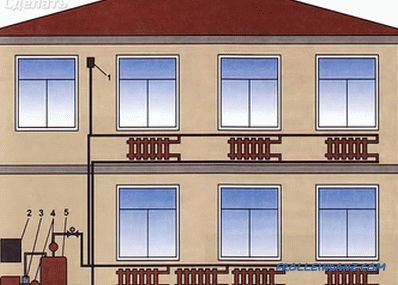 Self-flowing system
Self-flowing system
As already mentioned, in the gravity heating system there should be no height differences, otherwise it simply will not work. For this reason several contours can be made.
Single-circuit
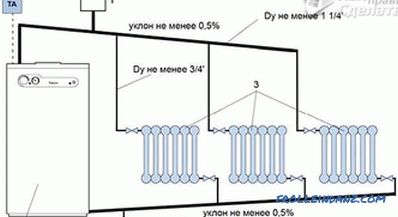 Connection circuit with natural circulation
Connection circuit with natural circulation
Everything is very clear here - one pipe goes from the boiler and the other goes to it, and batteries are connected between them. The presented scheme will help to understand this.
A single-circuit system can be a single-pipe one, only in this case it is necessary to take into account the factor that each successive battery in the self-flowing system will be more sensitively cooler than the previous one.
Dual-circuit
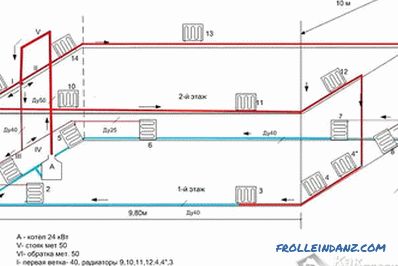 Dual-circuit system
Dual-circuit system
Dual-circuit systems may differ in direction coolant movement:
- With oncoming traffic.
- With passing traffic.
The choice of pipe mounting method taking into account the direction of coolant movement mainly depends on where the doors are located in the room or there are other nuances due to which the installation of the return in this place is impossible.
Regardless of the system selected, the pitch angle of the pipes does not change.
How to calculate the power of the batteries and the boiler heating
 How to calculate the power of the radiator
How to calculate the power of the radiator
There is no need to talk about exact results, since each house is individual and may differ in many parameters, which cannot be taken into account in the general scheme, and there is no need for that. Under ideal conditions, it is considered that for heating 1 m 2 60 W of radiator power is sufficient. It is quite clear that if the house is not insulated, simple wooden windows are installed in it, then it will be necessary to install more powerful batteries.
In order not to deal with the alteration later, it is important at the planning stage to find out what should be the capacity of the battery (or batteries) to be installed in a particular room. To do this, you can use one of two methods.
By volume
More accurate data can be obtained, given the volume of the room. We carry out measurements and, having received data on height, width and length of the room, we multiply them together, and multiply the result by 40 watts. Given the peculiarities of the structure, we introduce a correction factor.For:
- one-storey private house with an unheated attic - 1.5;
- rooms with a warmed wall - 1.1;
- rooms with an unheated wall - 1, 3;
It is important to consider the number of doors and windows.
- If there is an entrance door in the room, then another 150-200 W must be added to the resulting figure.
- If the windows are small and energy-intensive, then each will require another 70 watts.
- For large or non-insulated windows, add 100 W each.
By area
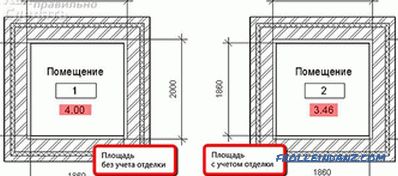 Room space
Room space
By calculating the number of batteries by the area of the room, the average indicator is used - 1 kW per 10 m 2 . By the same principle, the power of the heating boiler purchased for the house is calculated.
Consider an example of how to make calculations.
- There is a house with internal dimensions of 9 * 8 m. We multiply the width by the length and get the area - 72 m 2 .
- 72 m 2 we divide by 10 (1 kW per 10 m 2 ), and we get 7.2 - this is the power of the boiler in kW.
- Now we find out the battery capacity for a room of 2 * 4 m.
- The area turned out to be 8 m 2 .
- Using the same calculations as for the boiler, we get the figure 0.8 - the power of the battery in kW.
Now we will make amendments on climate zones. Consider the coefficients:
- In the Southern regions - 0.8-0.9.
- For the Far North - 1.5-2.
- In the zone of the Middle band - 1.2-1.4.
In our example, a 7.2 kW boiler was required. Taking into account the coefficient, we will calculate the final data for the Middle Band:
- 7.2 * 1.4 = 10.08.
- Given that the boiler must have a power reserve, we purchase a heating device with a capacity of 12-15 kW.
- In the same way, we approach the calculations of battery power for the room used in the example: 0.8 * 1.4 = 1.12 kW. Round up and get 1.2 kW.
The power of the battery is indicated in the passport of the product. If you are not sure of the correctness of your calculations, then purchase a more powerful radiator by installing a thermostat on it.
Installation
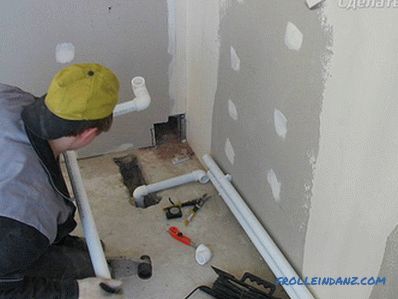 Installation of the self-flowing system
Installation of the self-flowing system
- How already mentioned, the boiler must be installed at the lowest point.
- No pipe should be below the level of the return entrance to our heater. Neglect of this requirement will lead to a significant deterioration of the heating system.
- A marking of the location of pipes and radiators is made on the walls.
- The radiators are mounted - their position is checked by the building level.
- A booster collector is mounted from the boiler supply pipe. It should be a pipe of large diameter.
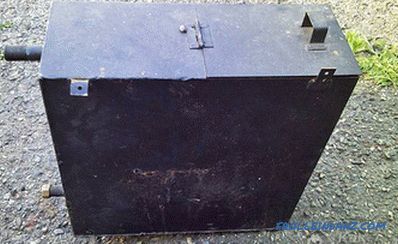 Expansion Tank for the House Heating System
Expansion Tank for the House Heating System
- At the top, set to open expansion tank. If it is in the attic, then the vessel and the pipeline must be thoroughly insulated.
- Pipes are mounted with a slope of 1 cm per linear meter of pipe. If it is not possible to adhere to this norm, then it is possible to reduce the drop to 0.5 cm, but not less. It should be borne in mind that with decreasing pipe slope, the efficiency of the entire heating system decreases.
- In the right place, the inset of the pipe leading to the radiator is performed. In the metal pipeline, the outlet can be welded or connected via a tee. When working with plastic pipes, you need to use fittings, soldering them, not forgetting taps and thermostats (if their installation is provided for).
- At the lowest point of the system (usually near the boiler), it is necessary to install a tap with a tap - through it water will be poured into the system.
When planning the production of a gravity system in a two-story house, you need to take into account that the coolant is supplied to the second floor, and then it goes down to the radiators installed on the first floor along the risers.
It remains to fill the system with water, and, checking it for leaks, heat the room without worrying that they can turn off the electricity.
Video
Watch a video on how to perform a heating calculation with natural circulation:
This video shows an example of heating with natural circulation:

